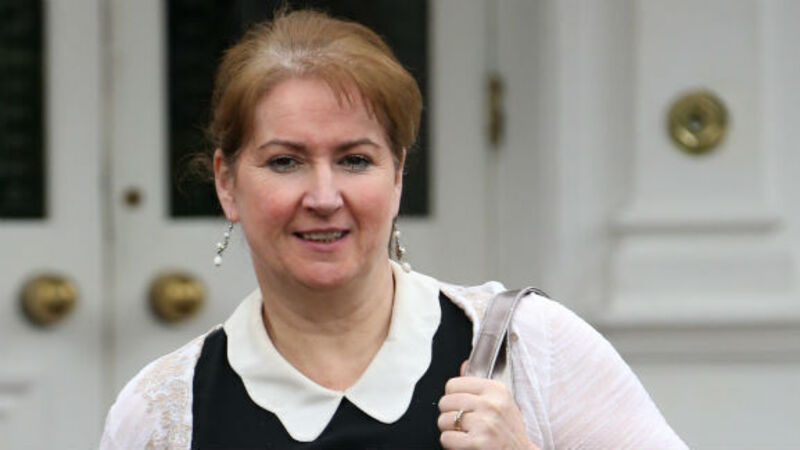Three recent inquiries raise questions over standards of maternity care

Three recent medical inquiries involving obstetricians have highlighted variations in the quality of Ireland’s maternity services, particularly in areas outside Dublin, writes
OVER the past year, three medical inquiries involving obstetricians have highlighted the variations in quality in the State’s maternity services, particularly in areas outside of Dublin.
This inequality can be seen in the lack of routine scans for fatal foetal abnormalities, and for families whose babies are born with life-threatening conditions.
Tipperary mother Laura Esmonde told a Medical Council inquiry late last year of the eerie moment she realised a consultant may have wrongly diagnosed an ectopic pregnancy, having advised medication that would terminate the pregnancy.
A few months later, an obstetric registrar came under review for the care she provided to six mothers in Sligo. After performing a Caesarean section on one of these mothers, the doctor left the lower half of the mother’s uterus “in the breeze” after suturing the top half to her abdominal wall.
Then, in June, the longest-running Medical Council inquiry, which investigated the care provided to three Cavan mothers during the births of their children, concluded. One of these babies died two days after his birth, one was stillborn, and one born in very poor condition.
In September 2016, Laura Esmonde, 39, of Tipperary, told a Medical Council fitness to practice inquiry that she attended the A&E at South Tipperary General Hospital on January 6, 2013, with a swollen leg.
A routine urine test revealed she was pregnant, which she had not known.
“I was shocked — it was a lot to take in, but I was happy to be pregnant,” said Ms Esmonde during her evidence on September 12, 2016.
On January 7, 2013, an ultrasound of her leg showed she had a clot. Ms Esmonde also asked for an ultrasound of her pelvis, because she wanted to see the baby. Her husband was due into the hospital shortly and she wanted to tell him the good news in person.
The stenographer said she couldn’t see anything, and called in a consultant radiologist. He also performed a scan, and Ms Esmonde said he told her there was a possibility that she had an ectopic pregnancy.
On January 8, the consultant obstetrician and gynaecologist under review — referred to as Dr A throughout the inquiry — performed a transvaginal scan. According to Ms Esmonde, he told her she had “an ectopic pregnancy of unknown location”.
“He told me my uterus was empty,” she added.
Dr A advised that she take methotrexate, a medication that stops cells from growing and can be used to terminate ectopic pregnancies. On the evening of January 8, 2013, Ms Esmonde took her first dose, and her second on January 18.
On January 26, Ms Esmond was transferred to Cork University Hospital for treatment of the clot in her leg, but a scan that day indicated her pregnancy was not ectopic.
A further scan showed an intrauterine gestational sac, but the pregnancy was no longer viable. The possibility of doing a D&C procedure later in the week to remove products from the uterus was discussed.
After that conversation with doctors, Ms Esmonde then returned to the ward.
“I was very upset. It was the eeriest of things. It was very distressing,” she said.
On January 29, a consultant came in to discuss the possibility of holding off on the D&C, and perhaps putting her on folic acid.
“For one split second, I thought maybe everything was going to be okay but immediately, I thought about the two doses of methotrexate and the damage that had been done to the baby,” said Ms Esmonde. “I was very upset. I was hobbling around the place, distressed.
“I was so angry. I said I can cope with things that happen to me but if anyone has hurt my baby, I was going to kill him.”
Ms Esmonde was successfully treated for the clot in her leg, and discharged from CUH on January 31. She then returned on February 2, suffering from abdominal cramping and bleeding.
A nurse did a scan and then an internal exam, and the pregnancy came out in the nurse’s hand “so I saw the sac in her hand”, said Ms Esmonde.
Dr Keelin O’Donoghue of Cork University Maternity Hospital told the inquiry that she found evidence of an intrauterine gestational sac when she performed a scan on Ms Esmonde on January 27, 2013. Dr O’Donoghue, the lead clinician for obstetric ultrasound and foetal medicine at CUMH, said she saw no mass signifying an ectopic pregnancy.
She did not see anything clearly within the sac, such as an embryo “but, for me, it looked like an intrauterine pregnancy,” said Dr O’Donoghue.
She added that three of her colleagues also saw evidence of an intrauterine gestational sac.
At the conclusion of the inquiry on December 12, 2016, Dr A was exonerated, and found not guilty of poor professional performance on seven counts.
‘I cut in the wrong place’
In December 2016, an obstetrician who made a number of clinical errors while treating six mothers was found guilty of poor professional performance on 17 counts.

Dr Andrea Hermann, who worked as an obstetrics and gynaecology registrar at Sligo General Hospital in 2013 and 2014, was also found guilty of professional misconduct on three counts.
In relation to one mother, referred to as Patient A, the inquiry found Dr Hermann failed to perform an elective Caesarean section with due skill, making an abnormal wound incision on the mother.
During her evidence, Patient A said Dr Hermann told her she “cut her in the wrong place” during an elective Caesarean section on December 4, 2013.
The mother-of-two told the inquiry that she suspected something was not right when she was still in hospital four days after giving birth, with a scar down the side of her abdomen, instead of across it.
She said that just as she was leaving the hospital, Dr Hermann brought her into a room and said: “I cut you in the wrong place.”
Patient A said Dr Hermann said by way of explanation that they were using new drapes — a large piece of fabric placed over the patient with a slit for the incision — during the surgery.
“At this point I didn’t know what to think,” Patient A told the inquiry. “I was very shocked. I was quite upset leaving the hospital.
“I was devastated,” she continued. “I couldn’t get my head around how she had made a mistake doing a planned section. “It’s been very hard over the past three years,” she added.
Dr Hermann failed to obtain informed consent from Patient B prior to carrying out a membrane sweep during an antenatal visit on August 15, 2013.
Patient B, a mother-of-three from Carrick-on-Shannon, Co Leitrim, said she was “shocked” after Dr Hermann performed the membrane sweep — an intervention used to induce labour — on her without her knowledge or consent.
Dr Hermann failed to establish whether Patient C still had a Mirena coil in place during a follow-up appointment. This patient later conceived and miscarried, the inquiry heard, although Patient C chose to give her evidence in private.
Dr Hermann also gave a blood-thinning drug, Innohep to a mother — referred to as Patient D — who was already at risk of heavy bleeding, as Patient D laboured with her sixth child on August 12, 2013.
Fortunately, the mother later gave birth without any complications.
On February 19, 2014, Dr Hermann performed a speculum examination on a pregnant Patient E, without first establishing the absence of placenta praevia.
Uterus ‘in the breeze’
Dr Hermann also failed to display adequate surgical skill in respect of the closure of a uterotomy on January 22, 2014, while performing a Caesarean section on Patient F. During her evidence, Dr Hermann’s former supervisor said Dr Hermann made “an astonishing mistake” while performing the section on Patient F.
Dr Hermann left the lower half of a mother’s uterus “in the breeze” after failing to suture the section properly, consultant obstetrician and gynaecologist Dr Heather Langan, from Sligo General Hospital, said.
Dr Langan spoke of the chaotic scene in the operating theatre on January 22, 2014, while Dr Hermann was performing an elective Caesarean section on Patient F. Dr Langan, who was in the theatre observing Dr Hermann, said the baby was delivered swiftly.
But Dr Langan then saw that the baby had a serious laceration on her head so she ran next door to get the general surgeon, in case they needed help with suturing the baby’s cut.
Upon her return, she found Patient F’s husband collapsed on the floor, having fainted, and staff were attending to him.
Dr Langan then turned her attention to the mother, and she remembered that Dr Hermann told her that she couldn’t see the ovaries.
Dr Langan became concerned when she looked at the mother, as she couldn’t see the bladder, and asked Dr Hermann to stop.
“What I found was that she had managed to suture the abdominal wall to the uterus, and had left the lower part of the uterus in the breeze, effectively,” said Dr Langan. “My concern was that what she had done in surgical terms made absolutely no sense. To miss the entire lower part of the uterus and not suture it — I’d never seen anyone do that. It’s an astonishing mistake.”
Dr Langan, who completed the surgery, said she was concerned the mother would bleed heavily if she had not intervened.
Dr Hermann was also the subject of a previous inquiry at the Medical Council, in 2009 and 2010. Before this, she worked in The Galway Clinic. She was suspended from June 2010 to June 2011.
On the first day of the inquiry, Dr Hermann’s solicitor, Gerard O’Donnell, of O’Donnell Waters solicitors in Galway, read out a statement on her behalf, before going off record.
Mr O’Donnell – who previously represented Savita Halappanavar’s husband, Praveen – said Dr Hermann admitted to the clinical allegations against her.Addressing the Medical Council in her statement, she said: “It feels to me you are disappointed that I’m still alive.”
Longest-running inquiry

November 2016 saw the start of the longest-running Medical Council inquiry to date — the case of consultant obstetrician and gynaecologist Dr Salah Aziz Ahmed, of Cavan General Hospital.
The inquiry investigated the care Dr Aziz provided to three mothers at Cavan General Hospital between 2012 and 2014.
Evidence — at times heart-breaking, at times tediously technical — was given by two of the three patients, a number of Cavan staff members, several expert witnesses and Dr Aziz himself. The inquiry heard details of Patient A, now 38, whose baby boy passed away 32 hours after he was born.
The baby was born by emergency Caesarean section on November 22, 2012, in very poor condition. He died on November 24, and a coroner’s court later found the cause of death to be extensive meconium aspiration as a result of hypoxic brain injury.
Eileen Barrington, BL, legal counsel for Dr Aziz, pointed out during the first day of the inquiry that it was not claimed that any of Dr Aziz’s actions caused the death of Patient A’s baby.
Patient A chose not to give evidence, and did not attend the hearing.
The inquiry, held in the unusual venue of Finnstown Castle Hotel in Lucan, Co Dublin, heard evidence from the second mother, Deirdre Clarke, who waived her right to anonymity.
Ms Clarke, 38, who was admitted to Cavan for an induction on June 5, 2013, was hoping to achieve a vaginal birth after a previous Caesarean section (VBAC).
She was given Syntocinon, a drug used to progress labour, but one that can lead to hyper-stimulation of the uterus and very strong contractions, which can distress the baby and increase the risk of uterine rupture.
That night, Ms Clarke required an emergency Caesarean section, after her uterus ruptured. She suffered a post-partum haemorrhage and her baby boy, Roland, was born in a very poor condition, requiring resuscitation.
After the surgery, Ms Clarke was transferred to a recovery room. “I didn’t know what way the baby was, whether it was a boy or a girl,” she said.
“At some point, I heard it was a boy, and that he had gone to the SCBU, the special care baby unit.” Roland was then transferred to the Rotunda, where “they were very concerned about him, and they didn’t know what the outcome would be,” said Ms Clarke.
Initial tests on Roland proved positive and he is now aged four and “a perfect little boy,” said Ms Clarke.
By the time Dr Aziz gave evidence in relation to Ms Clarke, the inquiry had moved to the normal venue of the Medical Council headquarters in Dublin City.
Dr Aziz defended his antenatal care of Ms Clarke, but began his evidence with an apology to her.
“I want to acknowledge the suffering and trauma Mrs Clarke went through,” Dr Aziz said. “I appreciate she’s been through a lot. I hope this process will bring closure to her.”
‘I didn’t expect him to die’
The inquiry sat in January, and then in March, when the mother referred to as Patient C — whose baby died inside her — gave her powerful and heart-breaking evidence.
Patient C’s baby boy was delivered stillborn after an emergency Caesarean section on April 26, 2014.
Baby C was his mother’s seventh pregnancy, as she had suffered three previous miscarriages in 2007, given birth to a stillborn baby girl in 2009, and then given birth to two live baby girls in 2010 and 2011.
In 2009, Patient C was diagnosed with a genetic blood-clotting disorder, and suffered two placental abruptions, or separation of the placenta from the uterus, prior to her pregnancy with Baby C.
Patient C told the inquiry that on the evening of April 25, 2014, when she was 32 weeks pregnant, she began to feel “very unwell”. The following morning she went to hospital, arriving at 12.40.
At 4.45pm, Patient C met with Dr Aziz, the consultant on call that day. She told him about her poor obstetric history, and he examined her. He said he would return at 7pm to perform a Caesarean section.
But shortly after 6pm “all hell broke loose”, said Patient C, after a midwife could not find the baby’s heartbeat. Patient C was rushed to theatre and given a general anaesthetic. “When I woke up, I knew something terrible had happened because [the nurse] was crying,” she said.
“After initially meeting my son, I was taken to the recovery room. I met my husband. We didn’t know what to say to each other.
“I didn’t expect him to die. … All that I wanted that day, to come out of that, is my little man to be delivered.”
During his evidence on March 28, Dr Aziz said he should have performed the section at 4.45pm, when he first met with Patient C.
“In hindsight, I regret not doing the section at that time,” Dr Aziz said. “Doing the section could have given the baby some chance of survival.” On May 18 this year, the inquiry committee which rules on the case found seven of the 14 allegations against Dr Aziz to be proven as to fact. On June 6, Dr Aziz was found not guilty of poor professional performance on six out of the seven counts. He was found guilty of poor professional performance on just one count, which related to the fact that he failed to decide that immediate delivery of Patient C’s baby by emergency section was required.
Dr Aziz was also cleared of professional misconduct on two counts.
More patient awareness
Brigid Doherty, CEO of national advocacy group Patient Focus, said patients are becoming more aware of their right to complain, due to recent investigations and inquiries highlighted in the media, and the increased visibility of Patient Focus and other advocacy and support groups.
But patients should receive explanations about their care long before any verdict in a Medical Council inquiry, Ms Doherty argued.
“Patients expect that if there is poor performance on the part of a doctor, it would be examined by the hospital and a decision made whether the practitioner is reported to the regulatory body.
“But we would hope that any unexpected outcomes or deficits in care would be acknowledged, and explanations given in a timely manner. Parents should not be forced to make complaints to get answers due to lack of local information,” she said.
















